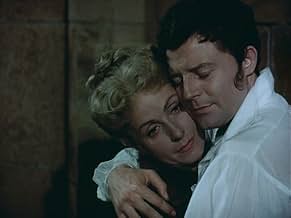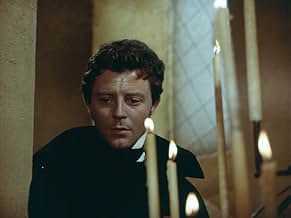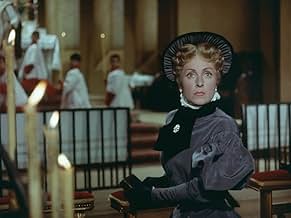Ajouter une intrigue dans votre langueIt's no holds barred for Julian in pursuit of upward mobility. Although expected to channel career aspirations into the Church of the post- Napoleonic era, his intensely romantic liaisons pr... Tout lireIt's no holds barred for Julian in pursuit of upward mobility. Although expected to channel career aspirations into the Church of the post- Napoleonic era, his intensely romantic liaisons propel him forward at a pace he cannot control.It's no holds barred for Julian in pursuit of upward mobility. Although expected to channel career aspirations into the Church of the post- Napoleonic era, his intensely romantic liaisons propel him forward at a pace he cannot control.
- Réalisation
- Scénario
- Casting principal
- Récompenses
- 3 victoires au total
Anna Maria Sandri
- Elisa
- (as Anna-Maria Sandri)
Jean-Marie Amato
- Le bottier
- (non crédité)
Avis à la une
Stendhal (Henri Beyle, 1783-1842) was a very difficult and debatabla author and extremely controversial as such, which he was all too well aware of himself, as he actually never expected his books to be read much, which they weren't in his day, while he foresaw, that "In 50 years, people will read me," which they did. He was fascinated by man's penchant for irrationality and enjoyed studying bizarre fates of people who threw themselves into trouble just for the thrill of it, especially if they knew how bad it was for them. In "Scarlet and Black" there are constant arguments of suicide, and although there is no actual suicide occurring in the novel, both the ladies are quite suicidal, while Julien Sorel himself proves his own pride by subjecting himself to them and wallowing in their suicidal natures. It is true, he really loves Madame de Renal, and she loves him, and they make a very credible couple, especially as Danielle Darrieux and Gerard Philipe are perfect for the roles, and both honour them perhaps more than they deserve. She is the one who ultimately destroys him, and it's intentional, and he takes the consequences and simply has to do what he can to destroy her in return in a glorious operatic performance of self-destruction. Stendhal's characters are no ideals, they are actually rather unsympathetic and highly egoistic, (Stendhal invented the term 'egotism',) but at the same time they are admirable for their consistency, as there never are any compromises. He wrote very few novels, they are among the most bizarre in world literature, but they will always remain fascinating. Claude Autant-Lara succeeds well in rendering, realizing and understanding the Stendhal syndrome, and the film is above all extremely stylish and beautiful, which high aesthetic qualities are greatly augmented by the exquisite music by René Cloérec, a composer hardly known at all, but his music here is enough to make him immortal. In brief, it is a very precious and unique production, for its aestheticism and exquisite beauty, doing honours to both the misanthrope Stendhal and the actors and the director, lifting out this extraordinary study in human destinies from the novel in rendering it alive on the screen.
A very good screening of Stendhal's novel. Danielle Darrieux and Antonella Lualdi are of great beauty. Gérard Philipe has his charm, but his best film is "Fanfan la Tulipe" (1952) directed by Christian-Jaque. Claude Autant-Lara has made many other very good films, such as "Four Bags Full" (1956) and "Love Is My Profession" (1958).
Many virtues . The first - maybe the accuracy to Stendhal message. The admirable chemistry between Gerard Philipe and Danielle Darrieux. And, not the less, the new Julien Sorel. Impressive for the nuances of a character escaping from the perspective about one side. Seductive for few scenes giving the essence of period. Serving profound humanism. A film with so many virtues ! One of them - the first steps of Antonela Lualdi. Not the best performance of her but a nice work .
Claude Autant-Lara had intended a three and a half hours movie,but the producers were not prepared to accept it;two shows a day was not profitable for an expensive movie filmed in color ,which was rare in France of the fifties;the precedent user was probably right when he wrote about the producers'cuts .SO the movie was divided into two parts ; the audience had to come twice (and to pay twice of course!) Autant-Lara was an auteur:his then anti-clericalism ,anti-militarism and he held in contempt the bourgeoisie (no Chabrol did not invent it,nor the N.V),hypocrisy and so called sacred values ."Douce" and "LE Diable Au Corps,among others,had already been released .The story like,romantic ,human side of the novel is almost absent .Madame De Rénal (who could remind the viewers of the female role of "Le Diable Au Corps" and mainly Mathilde De La Môle are relegated to supporting parts:and however they are played by Danielle Darrieux and Italian beauty Antonella Lualdi (co-production outcome)!The director and his screenwriters,Bost and Aurenche focused on the social side :Julien,a carpenter's son,dreams of social promotion ,but he does not belong there ,in the world of privileged persons ,protected by the Red (the army) and the Black (religion) .He puts his head in the guillotine because he is an intruder under the very reactionary reign of Charles the Tenth,like the young student of "Diable" or the proletarian couple of "Douce"....and later the conscientious objector in "Tu Ne Tueras Point".
Anyone familiar with Stendhal's "The Red and the Black" knows the tragic tale of Julien Sorel, a carpenter's son born too late to rise in Napoleon's army and escape his lowly station. In this 1954 adaptation, Gérard Philipe takes on the role of Julien, though at 32, he's too old to convincingly play the brooding, impetuous youth. Philipe's natural charm doesn't quite fit Julien's darker, more unpleasant nature.
Julien becomes a tutor for the sons of Mme de Rênal (Darrieux), a pious, repressed woman who inevitably falls for him. Their passionate affair is soon cut short by the looming threat of scandal. After a stint at a seminary, Julien finds himself working for the haughty Marquis de la Mole and tangling with his snobbish daughter, Mathilde (Lualdi), in a love-hate dynamic. Julien aims to seduce her out of pride, while Mathilde battles her attraction to someone beneath her station. Just as they become engaged, tragedy strikes with the vengeful return of Mme de Rênal.
Modern viewers might find Julien's constant self-pity and manipulative seductions tiresome. His endless monologues and twisted feelings about love don't do much to endear him, despite Philipe's solid performance. Darrieux's Mme de Rênal is hardly better - her tormented guilt feels more like a way to make adultery spicier. Thankfully, Lualdi as Mathilde injects some much-needed life into this otherwise gloomy affair.
The version I watched suffered from faded, drab colors, making it hard to appreciate the settings. Many scenes looked painfully staged, with windows opening onto what seemed like white backdrops. Not exactly visually stunning.
Julien becomes a tutor for the sons of Mme de Rênal (Darrieux), a pious, repressed woman who inevitably falls for him. Their passionate affair is soon cut short by the looming threat of scandal. After a stint at a seminary, Julien finds himself working for the haughty Marquis de la Mole and tangling with his snobbish daughter, Mathilde (Lualdi), in a love-hate dynamic. Julien aims to seduce her out of pride, while Mathilde battles her attraction to someone beneath her station. Just as they become engaged, tragedy strikes with the vengeful return of Mme de Rênal.
Modern viewers might find Julien's constant self-pity and manipulative seductions tiresome. His endless monologues and twisted feelings about love don't do much to endear him, despite Philipe's solid performance. Darrieux's Mme de Rênal is hardly better - her tormented guilt feels more like a way to make adultery spicier. Thankfully, Lualdi as Mathilde injects some much-needed life into this otherwise gloomy affair.
The version I watched suffered from faded, drab colors, making it hard to appreciate the settings. Many scenes looked painfully staged, with windows opening onto what seemed like white backdrops. Not exactly visually stunning.
Le saviez-vous
- AnecdotesAfter Marlon Brando had finished his stage commitment to "A Streetcar Named Desire," Claude Autant-Lara wanted the young actor, who had not yet made a movie, for "The Red and the Black." He paid for Brando's transportation to Paris to meet with him. Although Brando loved the French capitol, plans for the movie were delayed, and the film was not made until 1954 with Gérard Philipe.
- ConnexionsFeatured in Legendy mirovogo kino: Gérard Philipe
Meilleurs choix
Connectez-vous pour évaluer et suivre la liste de favoris afin de recevoir des recommandations personnalisées
- How long is The Red and the Black?Alimenté par Alexa
Détails
- Date de sortie
- Pays d’origine
- Site officiel
- Langue
- Aussi connu sous le nom de
- The Red and the Black
- Lieux de tournage
- Sociétés de production
- Voir plus de crédits d'entreprise sur IMDbPro
- Durée3 heures 25 minutes
- Rapport de forme
- 1.33 : 1
Contribuer à cette page
Suggérer une modification ou ajouter du contenu manquant

Lacune principale
By what name was Le rouge et le noir (1954) officially released in Canada in English?
Répondre






























